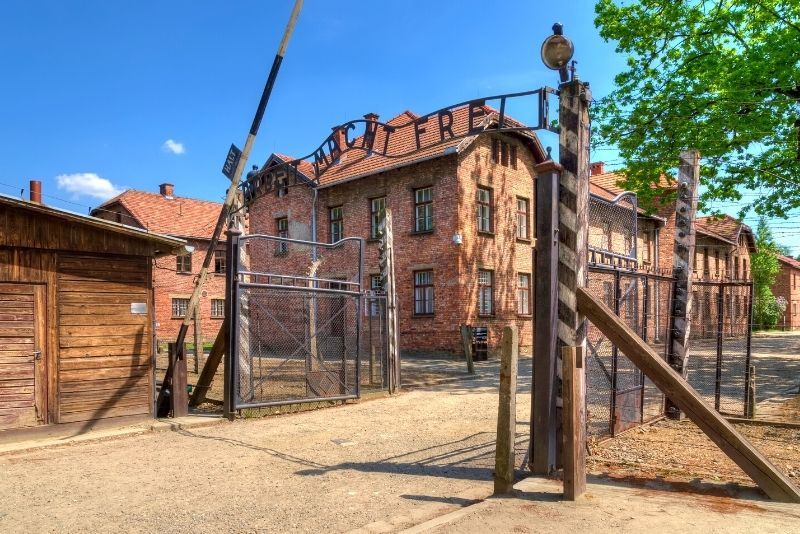Auschwitz: Day Trips and Tours from Warsaw
A visit to Auschwitz-Birkenau State Museum is not for the faint-hearted. The former German Nazi concentration camp and extermination camp in Poland represents a dark chapter in history. It reminds visitors of the atrocities of Nazi Germany and represents the torture and human cruelty that came with it.
On an Auschwitz day trip from Warsaw, take a crucial history lesson on this troubling aspect of Europe’s past and leave informed about the disturbing Holocaust era. Leave behind the glitz of this Polish capital for a visit steeped in somber history.
A visit to Auschwitz-Birkenau State Museum is not for the faint-hearted. The former German Nazi concentration camp and extermination camp in Poland represents a dark chapter in history. It reminds visitors of the atrocities of Nazi Germany and represents the torture and human cruelty that came with it.
On an Auschwitz day trip from Warsaw, take a crucial history lesson on this troubling aspect of Europe’s past and leave informed about the disturbing Holocaust era. Leave behind the glitz of this Polish capital for a visit steeped in somber history.

(0/24) checking Musement...
A visit to Auschwitz-Birkenau State Museum is not for the faint-hearted. The former German Nazi concentration camp and extermination camp in Poland represents a dark chapter in history. It reminds visitors of the atrocities of Nazi Germany and represents the torture and human cruelty that came with it.
On an Auschwitz day trip from Warsaw, take a crucial history lesson on this troubling aspect of Europe’s past and leave informed about the disturbing Holocaust era. Leave behind the glitz of this Polish capital for a visit steeped in somber history.

Here's all you need to know about Auschwitz, one of the most historical destinations for day trips from Warsaw.
How to get to Auschwitz from Warsaw?
The Auschwitz-Birkenau State Museum is situated in Oświęcim, an industrial town in Southern Poland, and it takes about 5 hours to drive from Warsaw’s Frederic Chopin airport.
From Warsaw to Auschwitz by car
The fastest driving route from Warsaw’s Old Town to Auschwitz takes approximately 4 hours. The journey is fairly straightforward, with the majority of the trip taking place along the S8 and A1 highways.
From Warsaw to Auschwitz by train
Taking a train to Auschwitz is also an option – this mode of transportation is fairly smooth and scenic, involving one transfer. Alight at the Warsaw Central train station and take the train until Katowice. Once there, change for trains heading for Auschwitz. Expect travel times to last over 5 hours each way.
Guided tour to Auschwitz from Warsaw
Joining guided tours is the easiest way to arrive at Auschwitz, as they take the hassle out of having to deal with your transport needs yourself. With pickups and drop-offs available from most accommodations in Warsaw, you can relax knowing you’ll be in the good hands of a knowledgeable driver-guide.
What is the typical itinerary?
Day trips to Auschwitz from Warsaw take a full day for an average of 12 hours, including about a 4-hour drive one way. Shorter trips usually involve a faster mode of transportation to the museum and only make a handful of stopovers, whereas longer tours visit multiple notable sites in one tour.
Excursions often include hotel collection and drop-offs from central locations in Warsaw. Travel is typically by air-conditioned coach or train, followed by a bus, depending on the tour.
Many tours make a pitstop at Krakow – a bustling medieval city in Southern Poland, on the way to Auschwitz.
Upon arrival at the museum, you will begin your tour of Auschwitz I with an expert local guide who will provide an introduction to the former Nazi extermination camp.
See the traces of cruelty through the well-preserved wooden watchtowers, barbed fences and railway ramps where the unloading of cars filled with humans took place.
You will then browse through the historical collections of implements that used to belong to the prisoners and some exhibits depicting their conditions at the camp.
Then, you’ll head onto the Birkenau extermination camp, just a short ride away, where over 90% of the people were executed. Here, you’ll learn all about the horrors of the Holocaust to enhance your knowledge of this fateful era.
Some Auschwitz day trips include a break for a hearty traditional Polish lunch midway through the excursion.
What kinds of tours are available?
There is a range of guided tours from Warsaw to Auschwitz that each ensures you are well-informed about Europe’s heartbreaking past. Hotel pickups and drop-offs are often included for a hassle-free journey.
Small group tours to Auschwitz from Warsaw
Guided tours to Auschwitz offer a fantastic introduction to the site, allowing for a more comprehensive discovery of all the atrocities that occurred during the Holocaust.
This is a smooth and comfortable journey in a small-group setting, including a walking tour of the Treblinka Concentration Camp.
Private tour to Auschwitz from Warsaw
Private tours to Auschwitz provide a more personalized experience. Journeys are typically by luxury vehicle or train and mean you avoid the hassle of having to get behind the wheel yourself.
Some tours also offer you the chance to explore Krakow accompanied by a private, knowledgeable guide after visiting the former concentration camp.
Day trip to Auschwitz plus Krakow from Warsaw
On most journeys from Warsaw, Krakow is on the way to Auschwitz, so expect this city to feature heavily on a number of day trips. You’ll make a stopover for a sightseeing tour of Krakow, before a sobering visit to Auschwitz-Birkenau.
Get filled in on the murderous Nazi campaigns against the Jewish population, discover artifacts and tuck into a traditional Polish lunch along the way.
How much does it cost?
Day trips to Auschwitz vary in price depending on the size of your group and the number of pitstops you make during your tour. The prices usually include hotel collection and drop-offs, round-trip transportation by coach or minibus, and an English-speaking guide.
Small group tours to Auschwitz from Warsaw cost €100 per person for a group of eight people.
Private tours to Auschwitz from Warsaw cost approximately €180 per person for a group of two, and provide entrance tickets to the museum and bottled water.
Day trips to Auschwitz plus Krakow from Warsaw cost around €200 per person for a group of seven, and provide basic lunch and admission to the museum and concentration camps.
What will you see on an Auschwitz day trip from Warsaw?
A visit to Auschwitz makes for a humbling experience that will encourage you to reflect on this troubled part of European history, as you discover former concentration camps, historic museums and medieval cities.
Auschwitz-Birkenau State Museum
This former Nazi concentration camp killed over 1 million Jews during the Second World War. There are two sections of the camp – Auschwitz 1 and the more expansive Birkenau. A visit to both well-preserved places offers essential insight into the magnitude and horror that occurred at this location.
The museum also displays several collections of artifacts excavated from the site. Discover the humanity of the prisoners through their personal belongings, which they took with them to the camp, including sewing kits, shaving tools, shoes, suitcases, and paperwork.
Krakow

This thriving medieval city and Poland’s former royal capital come alive at night and on the weekend. Thanks to its student-packed population, it offers the perfect mix of medieval pomp and modern youth-fueled fun.
On day trips to Krakow, you can take in the vibrant atmosphere and emblematic architecture. Visit the late-Gothic St. Mary's Basilica, marvel at the Renaissance Cloth Hall, and discover hidden gardens.
Treblinka Concentration Camp
You’ll feel like you’ve stepped back in time when you arrive at the village of Treblinka, where horses and carts still roam the streets. Once you’ve set foot on the Treblinka Concentration Camp, you’ll be standing above the ashes of over 900,000 Jews – almost all of which were Jewish.
They were murdered at the Treblinka death camp a short distance away. This is a must-visit for a powerful understanding of the Holocaust.
Wieliczka Salt Mine

An underground labyrinth of tunnels and chambers, the Wieliczka Salt Mine has been open to the public since 1722 and offers a unique perspective of the salt-hewn Polish formations.
Marvel at chapels with altarpieces, figures, statues and monuments that are composed entirely of salt. It took over three decades for just three men to complete this majestic temple, resulting in a salt mine masterpiece.
When is Auschwitz open over the year?
Auschwitz is open year-round apart from the most notable public holidays, including Jan. 1, Dec. 25, and Easter.
What are the opening times?
The opening times for Auschwitz vary according to the month of the year.
- December: 7:30 AM – 2 PM
- January and November: 7:30 AM – 3 PM
- February: 7:30 AM – 4 PM
- March and October: 7:30 AM – 5 PM
- April, May, and September: 7:30 AM – 6 PM
- June, July, and August: 7:30 AM – 7 PM
When is the best time to visit Auschwitz?
It’s best to visit Auschwitz between May and September when the weather is typically pleasant, so you can explore the region and enjoy sightseeing away from the frostier climate. However, if you want to avoid some of the peak season crowds, visit in spring from April to May.
Are there any tours to Auschwitz from other cities in Poland?
Yes, there are tours departing from other cities in Poland:
Travel tips
- Bring a passport or another form of photo ID documentation for entering the sites.
- Wear comfortable walking shoes for strolling around the museum, camps and Krakow.
- Pack warm layers if you’re visiting during the winter months, as temperatures are known to drop considerably during this season.
- Behave with solemnity and utmost respect at all times during your stay at Auschwitz.

